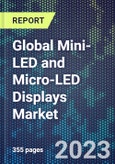Micro-LED is a self-emitting display consisting of arrays of microscopic LEDs each forming a pixel. Micro-LED commercial activity is picking on considerably. Apple has plans to invest>$2 billion in establishing smartwatch display production with an 8” Micro-LED chip fab at ams-Osram. Epistar and AUO are building a 6” Micro-LED foundry leveraging PlayNitride technology. AUO will also begin production of a smart watch display 1.39” in Q4 23. Jade Bird Display has commenced its production line in Hefei, with a total capacity of 120 million 0.13” Micro-LED panels. Several other companies have also set up pilot lines for production. and Samsung is planning to increase manufacturing of Micro-LED TVs in 2023.
The Global Market for Micro-LED Displays 2024-2034 is an in-depth 350 page market report providing a comprehensive analysis of the emerging Mini-LED and Micro-LED display technologies and markets. It evaluates the current status and future outlook for these next-generation LED displays across applications in consumer electronics, automotive, augmented reality, transparent displays, digital signage, and more. The report profiles over 80 leading companies developing Micro-LED products including display manufacturers, LED chip/emitter companies, equipment suppliers, and start-ups. It assesses their technology capabilities, product roadmaps, partnerships, and competitive positioning.
Detailed technical analysis is provided on Micro-LED manufacturing processes such as epitaxial growth, mass transfer techniques, assembly and interconnect technologies. The report compares performance metrics of Micro-LED displays including benefits/drawbacks versus LCD and OLED displays. In-depth market analysis is provided on adoption trends, drivers, and challenges across key industry verticals. Quantitative 10 year market forecasts are included for Mini-LED and Micro-LED display shipments and revenues globally and segmented by product categories, regions, and application markets.
Overall this report is the most comprehensive source of strategic analysis on the transformative Mini-LED and Micro-LED display technologies and associated market opportunities through 2034. It is a vital reference for display industry participants, investors, electronics OEMs, and technology companies seeking an in-depth understanding of these emerging displays.
Report contents include:
- Technology Introductions to Mini-LED and Micro-LED Displays
- Comparative Analysis of Mini-LED vs Micro-LED
- Manufacturing Processes for Mini-LED and Micro-LED Displays
- Chip Fabrication, Epitaxial Growth, Wafer Production
- Assembly, Hybrid Integration, Mass Transfer Techniques
- Defect Management, Repair and Optimization
- Colour Conversion Technologies for Micro-LED
- Analysis of Micro-LED Performance Metrics
- Assessment of Benefits and Drawbacks vs LCD and OLED
- Emerging Innovations: Flexible, Transparent, 3D Displays
- Adoption Roadmaps and Market Opportunities by Application:
- Consumer Electronics, Automotive Displays, Signage
- AR/VR Devices, Transparent Displays, Lighting, Medical
- Supply Chain Ecosystems for Micro-LED Displays
- Company Profiles of 80 Micro-LED Developers. Companies profiled include AUO, eLux, Innolux, Jade Bird Display, LG Display, Mikro Mesa, Mojo Vision, PlayNitride, Porotech, Q-Pixel, Samsung Electronics, Tianma, and Sony.
- 10-Year Market Forecasts for Micro-LED Display Shipments and Revenues
- Analysis of Market Drivers, Trends, and Technology Challenges
- Regional Markets: North America, Asia-Pacific, Europe, ROW
This product will be delivered within 1-3 business days.
Table of Contents
1 REPORT AIMS AND OBJECTIVES
Companies Mentioned (Partial List)
A selection of companies mentioned in this report includes, but is not limited to:
- Aledia
- ALLOS Semiconductors GmbH
- Apple
- AU Optronics Corporation
- Avicena
- BOE Technology Group Co., Ltd.
- CEA-Leti
- Cellid, Inc.
- Compound Photonics US Corporation
- Comptek Solutions Oy
- China Star Optoelectronics Technology (CSOT)
- C Seed
- eLux, Inc.
- Epileds Technologies
- Epistar
- EpiPix Ltd.
- Focally
- Foxconn Electronics
- Fronics
- HannStar Display Corp.
- HC SemiTek Corporation
- HCP Technology HCP Co., Ltd.
- iBeam Materials, Inc.
- Innolux Corporation
- Industrial Technology Research Institute (ITRI)
- Innovation Semiconductor
- Jade Bird Display (JBD)
- Japan Display Inc. (JDI)
- Konka Group
- Kopin Corporation
- Kubos Semiconductors
- Kulicke and Soffa Industries, Inc.
- Kura Technologies
- Kyocera Corporation
- LedMan Optoelectronics Co., Ltd.
- Lextar
- Leyard OptoElectronic
- LG Display Co., Ltd.
- Lumens
- Lumiode, Inc.
- MICLEDI Micro displays
- Micro Nitride Co., Ltd.
- Mikro Mesa Technology Co., Ltd.
- Mojo Vision, Inc.
- Shenzhen MTC
- Nanosys, Inc.
- Nationstar
- Nichia Corporation
- NS Nanotech
- NthDegree
- PlayNitride, Inc.
- Plessey Semiconductors Ltd
- Poro Technologies Ltd (Porotech)
- Raysolve Technology
- RiTdisplay Corporation
- Q-Pixel
- QNA Technology
- QubeDot GmbH
- QustomDot BV
- Raysolve Technology
- Rohinni LLC
- Royole Corporation
- Samsung Display Co., Ltd
- San'an Optoelectronics Co., Ltd.
- Saphlux, Inc.
- Seoul Semiconductor/Seoul Viosys Co., Ltd.
- Sharp Display Technology (SDTC)
- Shenzhen SiTan Technology Limited
- SiliconCore Technology, Inc.
- Sitan Technology
- SmartKem
- Sony
- Stratacache
- Sundiode Inc
- TCL Electronics
- Terecircuits Corporation
- Tianma Microelectronics Co., Ltd.
- Toray Engineering
- Unity Opto Technology Co., Ltd
- VerLASE Technologies LLC
- Visionox Technology, Inc.
- VueReal
- Vuzix Corporation
- Xiamen Changelight Co., Ltd.
- X-Display
Methodology

LOADING...








